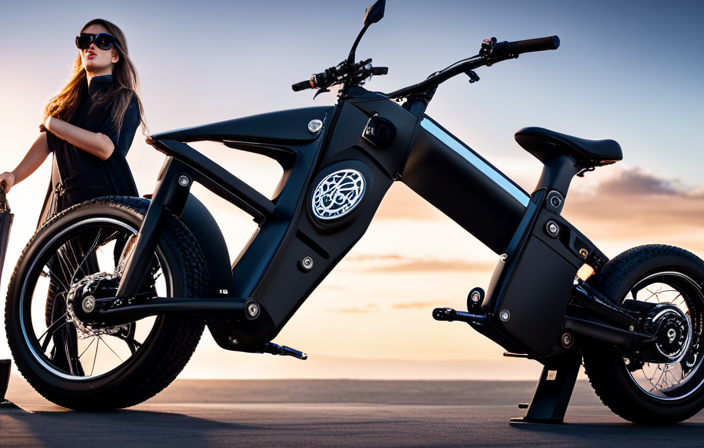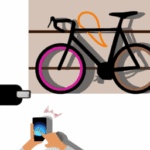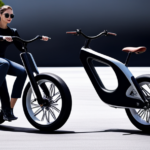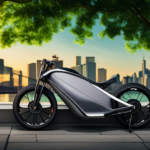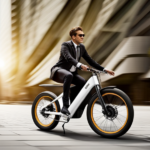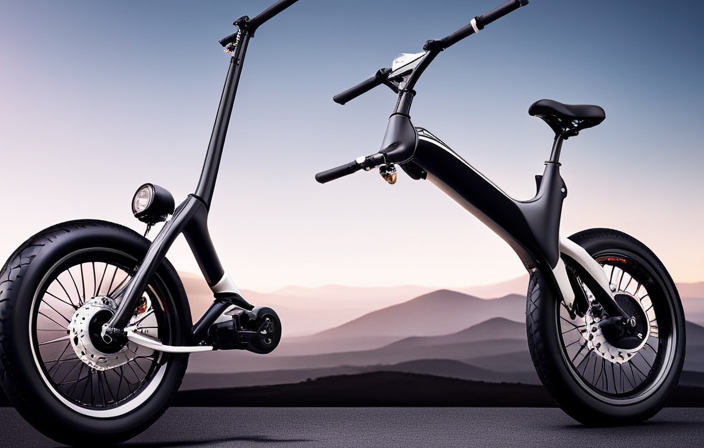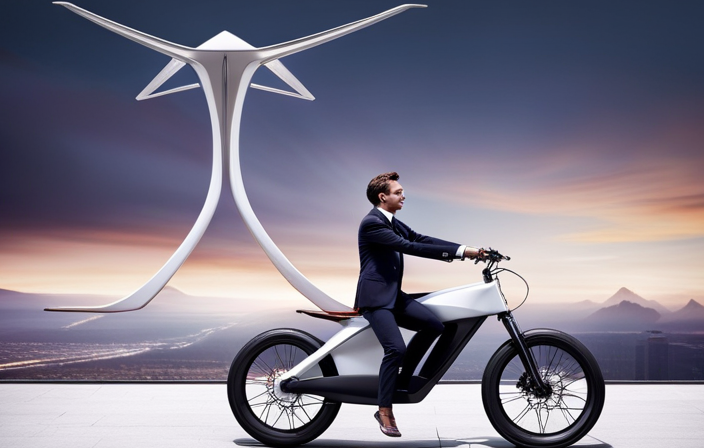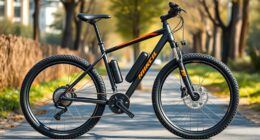Picture yourself experiencing the liberty of smoothly cruising the streets on your electric bike, fueled by clean and sustainable energy. However, in order to ensure your bike continues to run efficiently, it is important to understand how to properly charge it at home.
Just like a heart needs a steady beat, your electric bike’s battery needs a reliable charge. In this article, we’ll guide you through the process of charging your electric bike at home, ensuring you always have the power to go the distance.
Key Takeaways
- Use the original charger and charge in a cool and dry environment.
- Regularly monitor the charging progress using a digital display or smartphone app.
- Troubleshoot common charging issues by checking for errors, ensuring proper grounding, and monitoring voltage and temperature.
- Extend battery lifespan and promote efficient charging by avoiding deep discharges, following manufacturer’s guidelines, and using a high-quality charger.
Understand Your Electric Bike’s Battery Specifications
You should start by understanding your electric bike’s battery specifications. This knowledge is crucial for charging time optimization and battery capacity preservation.
First, you need to know the battery’s voltage and capacity, as this will determine how long it takes to charge. Higher voltage batteries generally charge faster. Additionally, understanding the battery’s capacity will help you gauge how far you can ride before needing to recharge.
It is also important to know the type of battery your electric bike uses, whether it is a lithium-ion or lead-acid battery. Each type requires different charging methods and precautions.
Once you have a clear understanding of your electric bike’s battery specifications, you can move on to choosing the right charging equipment to ensure efficient and safe charging.
Choose the Right Charging Equipment
When it comes to choosing the right charging equipment for your electric bike, there are a few key points to consider.
First, you’ll want to make sure you have the appropriate charging cables and connectors that are compatible with your bike’s battery. This will ensure a safe and efficient charging process.
Additionally, you’ll need to decide between a wall charger and a portable charger. Wall chargers are more convenient for at-home charging, while portable chargers offer flexibility for on-the-go charging.
Ultimately, the choice will depend on your specific needs and lifestyle.
Charging Cables and Connectors
To charge an electric bike at home, it’s important to have the right charging cables and connectors. Proper charging cable maintenance is essential to ensure the longevity and efficiency of your electric bike’s charging system. Regularly inspect the cables for any signs of wear or damage and replace them if necessary.
When choosing a charging cable, you’ll also have different length options to consider. A shorter cable may be more convenient for home charging, while a longer cable can provide flexibility when charging on the go.
Now that you have the right cables and connectors, the next step is to decide between wall chargers and portable chargers. While wall chargers offer faster charging times and convenience, portable chargers provide the flexibility to charge your electric bike wherever you go.
Wall Chargers vs. Portable Chargers
Wall chargers and portable chargers offer different benefits and can cater to various charging needs. When it comes to efficiency, portable chargers are a great option. They are compact and lightweight, making them easy to carry around and charge your electric bike wherever you go.
Portable chargers usually have a lower charging capacity compared to wall chargers, but they make up for it with their convenience. On the other hand, wall chargers provide a faster and more powerful charging experience. They are specifically designed to deliver a higher charging capacity, allowing you to charge your electric bike in a shorter amount of time. With wall chargers, you can simply plug in your bike and leave it to charge while you attend to other tasks.
As you consider which charger to use for your electric bike, keep in mind your charging needs and the level of convenience or efficiency you require.
Now, let’s move on to finding a suitable charging location.
Find a Suitable Charging Location
Choose a convenient location in your home to charge your electric bike. When identifying a safe charging spot, consider a well-ventilated area to prevent overheating and ensure proper ventilation. It is important to find a location away from flammable materials and avoid charging near water sources. Also, make sure the area is easily accessible and has enough space to accommodate the bike and charging equipment. To help you visualize, here’s a table that compares different charging locations based on their pros and cons:
| Charging Location | Pros | Cons |
|---|---|---|
| Garage | Easy access, protection | Limited ventilation |
| Outdoor shed | Ventilation, space | Exposure to weather elements |
| Basement | Ventilation, protection | Limited accessibility |
| Spare room | Ventilation, accessibility | May take up valuable space |
Once you have found the perfect spot, you can proceed to connect the charging equipment to your electric bike. Make sure the charging cable is securely plugged into both the power outlet and your eBike’s charging port. Always check the manufacturer’s guidelines on how to charge an eBike safely to prevent any potential damage to the battery. Allow the battery to charge fully before disconnecting it to maximize its lifespan and performance.
Connect the Charging Equipment to Your Electric Bike
Find a suitable spot in your chosen location and connect the charging equipment to your e-bike. Before connecting, make sure that the charging equipment is compatible with your electric bike. Different models may require different charging ports or voltage levels, so it’s important to check the specifications.
Once you have confirmed compatibility, ensure that both the charging equipment and your e-bike are turned off before connecting them. This will prevent any potential electrical hazards. When connecting, insert the charging plug into the corresponding port on your e-bike and secure it firmly. Double-check that the connection is secure to avoid any interruptions during the charging process.
Now that you have connected the charging equipment to your e-bike safely, you can proceed to the next step of setting the charging mode and time.
Set the Charging Mode and Time
To effectively charge your electric bike at home, you will need to understand the difference between standard charging and fast charging.
Standard charging typically takes longer but is gentler on the battery, while fast charging provides a quicker charge but can put more stress on the battery.
Additionally, setting a timer for overnight charging can help ensure that your bike is fully charged and ready for use in the morning.
By carefully selecting the charging mode and time, you can optimize the charging process and prolong the lifespan of your electric bike’s battery.
Standard Charging vs. Fast Charging
When it comes to charging your electric bike at home, there are two options: standard charging and fast charging. Here are some things to consider:
-
Fast charging safety: While fast charging can get your bike ready to ride in a shorter time, it is important to note that it may put more stress on the battery, leading to potential safety risks. It is crucial to follow the manufacturer’s guidelines and not exceed the recommended charging speed.
-
Benefits of standard charging: Standard charging, on the other hand, is a safer option that allows the battery to charge at a slower rate, reducing the risk of overheating or damaging the battery. It is also more energy-efficient, which is beneficial for the environment and can save you money on your electricity bill.
-
Longer battery lifespan: Standard charging helps prolong the lifespan of your battery by avoiding excessive heat and stress on the cells.
-
Battery health maintenance: Standard charging allows the battery to fully charge and discharge, which helps maintain its overall health and capacity.
-
Overnight charging convenience: Setting a timer for overnight charging ensures that your electric bike is fully charged and ready to go in the morning. This way, you can conveniently start your day without worrying about the battery level.
Now, let’s move on to the next section, where we will discuss how to set a timer for overnight charging.
Setting a Timer for Overnight Charging
Setting a timer for overnight charging ensures that your e-bike will be fully charged and ready to go in the morning. Not only does this method allow you to conveniently charge your bike while you sleep, but it also helps in achieving energy efficient charging.
By setting the timer, you can take advantage of off-peak electricity rates, which can save you money in the long run. Additionally, overnight charging allows your battery to charge at a slower pace, which is better for the overall health and lifespan of the battery. It reduces the risk of overcharging and overheating, extending the battery’s longevity.
Monitoring the charging progress is important to ensure that the battery is charging properly and to prevent any potential issues.
Monitor the Charging Progress
You can easily monitor the progress of charging your electric bike at home. This allows you to keep an eye on the battery health and optimize the charging speed. Here are three ways to monitor the charging progress:
-
Use a digital display: Many electric bikes come with a built-in digital display that shows the battery level and the charging progress. This allows you to track how much charge is remaining and how long it will take to complete the charging process.
-
Utilize a smartphone app: Some electric bike manufacturers offer smartphone apps that connect to your bike’s battery and provide real-time information about the charging status. These apps often include additional features like battery diagnostics and maintenance reminders.
-
Install a smart charger: Smart chargers have advanced monitoring capabilities and can provide detailed information about the charging process. They often come with a companion app or display that allows you to track the charging progress and adjust settings for optimal charging.
By monitoring the charging progress, you can ensure that your electric bike’s battery remains in good health and maintain proper battery care.
Maintain Proper Battery Care
To maintain proper battery care, it’s important to follow the recommended charging and storage guidelines. Battery maintenance is crucial for maximizing battery performance and ensuring that your electric bike runs smoothly.
When charging your bike at home, make sure to use the charger that came with your bike. Avoid using generic chargers as they may not be compatible and could cause damage to the battery. It’s also important to charge your battery in a cool and dry environment, away from direct sunlight and extreme temperatures.
Additionally, avoid overcharging your battery as it can lead to decreased battery life. Lastly, regularly check the battery connections and clean them if necessary to ensure proper charging. By following these battery care tips, you can maximize the performance and lifespan of your electric bike’s battery.
Now, let’s move on to troubleshooting common charging issues.
Troubleshoot Common Charging Issues
If you’re experiencing issues with charging your electric bike at home, there are a few common problems you may encounter.
One common issue is charging errors and fault codes, which can indicate a problem with the charging system.
Another thing to check for is loose connections, as a loose or damaged connection can prevent the battery from charging properly.
By troubleshooting these issues, you can ensure that you’re able to charge your electric bike effectively and avoid any potential problems.
Charging Errors and Fault Codes
Charging errors and fault codes can sometimes occur when charging an electric bike at home. These issues can be frustrating, but with a little troubleshooting, you can easily resolve them. One common charging mistake is not plugging the charger into a properly grounded outlet. This can lead to fault codes and errors. Another mistake is using an incorrect charger or power adapter, which may not provide the necessary voltage or current for your electric bike. To help you understand these errors and fault codes better, here is a table that highlights some common ones and their possible causes:
| Fault Code | Possible Cause |
|---|---|
| E-01 | Charger not properly plugged in |
| E-02 | Incorrect charger or power adapter |
| E-03 | Overheating of charger |
| E-04 | Battery voltage too low |
| E-05 | Battery temperature too high |
Remember to always check for loose connections before starting the charging process. This will ensure a smooth and error-free charging experience.
Check for Loose Connections
Before you begin charging your electric bike, it is important to check for any loose connections. This step is crucial for proper battery maintenance and charging safety. Loose connections can result in inefficient charging, reduced battery life, and potential safety hazards. To avoid these issues, here are five things to check for:
- Make sure the charging cable is securely plugged into both the bike and the power source.
- Inspect the connector pins for any signs of damage or corrosion.
- Check that the charging port on the bike is clean and free from debris.
- Examine the power outlet for any loose or damaged wiring.
- Verify that the charger itself is in good condition, with no frayed wires or loose components.
By taking the time to check for loose connections, you can ensure a safe and efficient charging process that will help extend the battery’s lifespan.
Extend the Battery’s Lifespan
To extend the lifespan of your electric bike’s battery, there are a few key points to keep in mind.
First, avoid deep discharges by recharging your battery before it reaches a critically low level. This will help prevent irreversible damage to the cells.
Secondly, regularly use and recharge the battery, even if you’re not planning to ride for long distances. This will help keep the battery active and prevent it from deteriorating due to long periods of inactivity.
Finally, make sure to follow the manufacturer’s recommended charging and storage guidelines to ensure optimal performance and longevity of your battery.
Avoid Deep Discharges
One important thing to remember is that you shouldn’t let your electric bike’s battery get too low. Proper battery maintenance is crucial to prolonging the lifespan of your electric bike’s battery.
Deep discharges can significantly reduce the battery’s longevity, so it’s essential to avoid them. When the battery is discharged to a very low level, it puts extra stress on the cells, which can lead to irreversible damage over time.
To prevent deep discharges, make sure to charge your electric bike’s battery regularly. It’s recommended to recharge the battery when it reaches around 20-30% capacity. By regularly using and recharging the battery, you can ensure its optimal performance and longevity.
Regularly Use and Recharge the Battery
Make sure you regularly use and recharge your battery to maintain its optimal performance and longevity. Battery maintenance is crucial for maximizing battery life.
Electric bike batteries are designed to be used regularly, and letting them sit unused for extended periods can lead to deterioration. By regularly using and recharging your battery, you can keep it in good condition and prevent deep discharges.
It is recommended to ride your electric bike at least once a week and recharge the battery after each use. This will help keep the battery cells active and prevent them from losing capacity. Additionally, using a smart charger can help optimize the charging process and ensure the battery is charged efficiently.
By following these battery maintenance practices, you can ensure that your electric bike is always ready to ride.
Now let’s move on to additional tips for efficient charging.
Additional Tips for Efficient Charging
Charging an electric bike at home is more efficient when you use a high-quality charger. To maximize charging efficiency and optimize charging time, there are a few additional tips to keep in mind.
Firstly, it is important to charge your electric bike in a cool and dry place, away from direct sunlight or extreme temperatures. This helps prevent overheating and prolongs the battery life.
Secondly, it is recommended to charge the battery to its full capacity whenever possible, as partial charging can affect its overall performance. Additionally, try to avoid leaving the battery on the charger for an extended period of time after it reaches 100%, as this can also impact its longevity.
Lastly, it is advisable to follow the manufacturer’s guidelines and recommendations for charging your specific electric bike model. By following these tips, you can ensure an efficient and effective charging experience for your electric bike at home.
Frequently Asked Questions
How long does it take to fully charge an electric bike battery?
It typically takes around 4-6 hours to fully charge an electric bike battery. To ensure the best results, it’s recommended to charge your bike overnight using a dedicated charger and following the manufacturer’s instructions for best practices.
Can I charge my electric bike battery with a regular power outlet?
Yes, you can charge your electric bike battery with a regular power outlet, but be cautious. While it’s an alternative option, there are potential risks involved. Using a dedicated charger is recommended for safety and optimal charging.
Is it safe to leave my electric bike charging overnight?
It is not recommended to leave your electric bike charging overnight due to potential dangers such as overcharging and overheating. To maximize the lifespan of your battery, charge it for the recommended time and avoid extreme temperatures.
Can I use a different brand of charger for my electric bike battery?
Can you risk using a different brand charger for your electric bike battery? While it may seem convenient, compatibility issues can lead to potential risks like overheating and damage. Stick to your bike’s recommended charger for optimal safety and performance.
How often should I charge my electric bike battery to maintain its performance?
To maintain optimal performance, it is recommended to charge your electric bike battery after each use or when it reaches 20-30% capacity. Charging duration should be around 3-5 hours for a full charge.
Conclusion
In conclusion, by understanding your electric bike’s battery specifications and choosing the right charging equipment, you can ensure efficient charging. Finding a suitable charging location and connecting the charging equipment are also important steps in the charging process. Additionally, setting the charging mode and time, as well as maintaining proper battery care, can help extend the battery’s lifespan. By troubleshooting common charging issues and following additional tips, you can enjoy the convenience and eco-friendly benefits of your electric bike for years to come.
So, charge up, ride on, and embrace the future of transportation!

